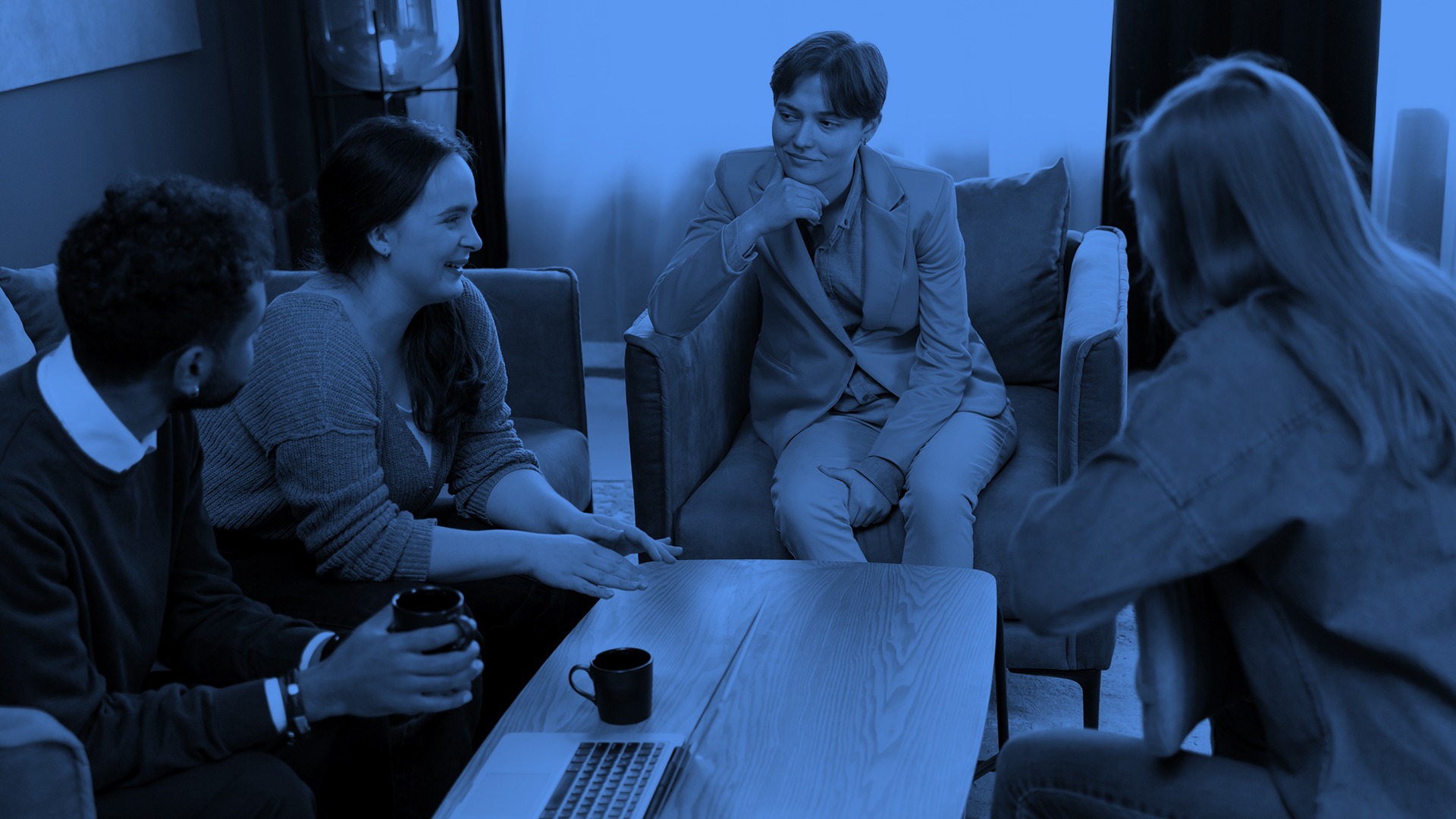Imagine stepping into your office on a typical Monday morning, greeted by the bustling energy of your colleagues as they engage in various conversations and activities. Amidst this flurry of interactions lies a complex web of office dynamics, shaped by the principles of group psychology.
In the workplace, understanding group psychology is crucial for navigating the intricate dynamics that influence our interactions, decisions, and relationships. In this blog we delve into the mysteries of group behavior, and how we can unlock the keys to successful collaboration, leadership, and overall organizational success.
Key Concepts in Group Psychology
Social Identity Theory:

The concept of social identity is a fundamental aspect of group psychology. It pertains to our sense of belonging and affiliation with specific groups, such as our team, department, or company. Our identification with these groups significantly influences our attitudes, behaviors, and interactions within the workplace. Social identity theory underscores the importance of group membership in shaping our self-concept and guiding our actions.
Groupthink:
Groupthink is a psychological phenomenon observed in cohesive groups where the desire for unanimity and conformity leads to suboptimal decision-making processes. The term was first coined by Irving Janis, a renowned psychologist, who defined groupthink as a mode of thinking that prioritizes consensus and harmony over independent critical thinking. When groups strive for unanimity, members may overlook dissenting opinions, ignore potential risks, and fail to consider alternative solutions, ultimately leading to flawed decision-making processes and missed opportunities for innovation. Identifying the signs of groupthink, such as overconfidence, closed-mindedness, and pressure for conformity, is essential to create a constructive environment for rational discussion and debate within teams.
Conformity:

Within group settings, individuals often experience pressure to conform to group norms and expectations, even at the expense of their beliefs or values. This conformity can stem from various factors, including the desire for acceptance, fear of rejection, or perceived authority of group leaders. While conformity can foster cohesion and cooperation within teams, it may also stifle individual creativity and critical thinking, limiting the group’s potential for growth and innovation.
Social Loafing:
One of the common occurrences in group dynamics is social loafing. This phenomenon describes the tendency of individuals to put in less effort when working collaboratively than when working independently. This decrease in effort can stem from the diffusion of responsibility, where individuals feel less answerable for their contributions when working in a group setting. Social loafing emphasizes the significance of cultivating a sense of personal accountability and motivation within teams to uphold productivity and overall performance.
Decoding Office Dynamics
Formal vs. Informal Groups:

In every workplace, various types of groups can form, both formal and informal. Formal groups, such as project teams or departments, have defined structures and objectives that guide their work. On the other hand, informal groups can be formed spontaneously, based on shared interests or personal connections among employees. These groups can be beneficial for socializing and building relationships, but can also create cliques and lead to office politics if not managed properly.
Understanding the dynamics of both formal and informal groups is crucial for success in the workplace, as it can help individuals navigate office politics, build effective relationships, and leverage social networks to achieve organizational goals.
Leadership Styles:
The leadership style adopted by a leader can have a profound impact on the way a group functions and the overall culture of an organization. There are various leadership styles such as authoritarian, democratic, and laissez-faire, each of which can influence communication patterns, decision-making processes, and team morale differently. For example, authoritarian leaders may prefer to tightly control group activities, whereas democratic leaders encourage participation and collaboration among team members. It is crucial to understand the strengths and limitations of different leadership styles to promote effective teamwork, foster employee engagement, and drive organizational success.
Communication Dynamic:
Collaboration and teamwork are crucial for the success of any organization. However, these cannot be achieved without effective communication. Communication patterns and the flow of information within groups play a critical role in shaping the decision-making process, resolving conflicts, and building a culture of openness and trust. It is vital to have clear, concise, and respectful communication to ensure that messages are understood and objectives are aligned across team members. By promoting active listening, constructive feedback, and transparent information sharing, organizations can improve their communication dynamics and foster a collaborative work environment. A team that communicates effectively not only increases productivity but also strengthens relationships, creating a positive impact on the organization’s overall performance.
Conflict and Competition:

Group dynamics are complex and can sometimes lead to conflict and competition among team members. These can arise from differences in goals, interests, or perspectives, and can be either positive or negative. On the one hand, conflict can be a catalyst for growth, learning, and innovation within teams, by bringing out different viewpoints and encouraging constructive dialogue. On the other hand, it can also lead to interpersonal tensions, divergent opinions, or competing priorities. To address these issues, healthy conflict resolution strategies are essential, such as active listening, empathy, and compromise. By using these techniques, teams can work through underlying issues and reach mutually beneficial solutions. Similarly, healthy competition can motivate individuals to strive for excellence, push boundaries, and achieve collective goals. However, it needs to be managed transparently and fairly within the organization to avoid negative outcomes. Ultimately, the key to successful teamwork is to recognize and leverage the strengths and weaknesses of each team member, while fostering an environment of respect, trust, and collaboration.
Strategies for Navigating Office Dynamics
Building Trust and Rapport:
Trust is the foundation of effective teamwork and collaboration. By demonstrating reliability, integrity, and respect in their interactions with colleagues, individuals can cultivate trust and rapport within teams. Building positive relationships based on mutual respect and understanding fosters a supportive work environment where team members feel valued, empowered, and motivated to contribute their best.
Effective Communication:
Clear, concise, and respectful communication is essential for avoiding misunderstandings and promoting alignment within teams. Effective communicators listen actively, express themselves clearly, and seek feedback to ensure that messages are understood and objectives are aligned across team members. By fostering open dialogue, transparency, and empathy, organizations can enhance communication dynamics and facilitate collaboration within teams.
Managing Conflict:

Conflict is a natural and unavoidable occurrence that can arise in any group dynamic. However, it should not be considered as a negative aspect, but rather as an opportunity for growth and innovation. By adopting an open dialogue, displaying empathy, and collaborating, teams can effectively manage and resolve conflicts. By acknowledging and addressing underlying issues, respecting diverse perspectives, and seeking mutually beneficial solutions, teams can manage conflicts constructively, strengthen their relationships, and improve their overall performance.
Leveraging Group Strengths:
To achieve collective success, organizations must recognize and leverage the unique strengths and talents of their team members. This can be accomplished by embracing diversity and inclusion, which can bring a wealth of perspectives and ideas to the table, driving innovation. Effective team leaders play a vital role in this process by identifying the strengths and weaknesses of individual team members, assigning tasks accordingly, and creating a culture of collaboration and mutual support. By doing so, they can harness the collective expertise, creativity, and enthusiasm of their team members, leading to efficient and effective problem-solving and goal achievement. In this way, organizations can overcome challenges, seize opportunities, and achieve their objectives with greater speed and success.
Conclusion
Understanding group psychology is crucial for navigating the complex dynamics of the modern workplace. By grasping key concepts such as social identity, groupthink, conformity, and social loafing, individuals can gain insights into their behavior and interactions within teams. With effective communication strategies, conflict resolution skills, and relationship-building techniques, employees can foster collaboration, drive innovation, and achieve success in their professional endeavors. As we embark on our journey through the maze of office dynamics, let us remember the power of self-awareness, adaptability, and empathy in building strong and resilient teams. By embracing diversity, fostering open dialogue, and leveraging the collective strengths of our teams, we can create a workplace culture where everyone thrives and contributes to our shared success.

